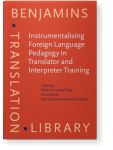Chapter 14
Developing translation sub-competences by implementing Content and Language Integrated Learning (CLIL)
Translator training in Chile faces the challenge of developing the students’ linguistic competence and translator competence (TC). This chapter explores the use of Content and Language Integrated Learning (CLIL) as a means to thematically articulate a language and a translation course in an undergraduate translation program. Three CLIL-based thematic units are delivered in an English language course. The academic results of the fifteen students suggest an academic improvement in the translation course in comparison to previous cohorts. Nine of those participants and the translation lecturer engage in semi-structured interviews to explore their perceptions of the approach. The findings indicate that CLIL performs an enabling function in fostering the development of TC in the translation course.
Article outline
- 1.Introduction
- 2.CLIL for B language teaching: A proposal for Chilean translator training
- 3.Context and participants
- 4.What to teach and what to learn: Designing a CLIL-based syllabus
- 5.CLIL-based materials and assessment
- 6.Discussing the students’ academic performance in translation
- 7.Exploring students’ and lecturers’ CLIL-related perceptions
- 7.1Exploring the students’ perceptions of CLIL
- 7.2Transferable skills to the translation classroom: The translation lecturer’s view
- 8.Conclusion
-
Notes
-
References
